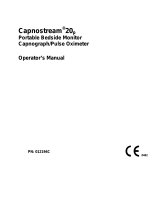Page is loading ...

Quick Guide to using the Oximeter
Congratulations on taking delivery of your oximeter – a life saving piece of technology for
use in the operating theatre and the hospital wards. (figure 1)
!!!
figure 1
What does the oximeter measure?
An oximeter measures the oxygen saturation of haemoglobin (Hb) in the arterial blood with each heart
beat. The peripheral oxygen saturation of healthy people should be more than 95% at all times,
including during anaesthesia. This value is called the SpO
2
.
Using the oximeter during anaesthesia
The oximeter detects falling oxygen saturation accurately. If the SpO
2
starts to fall, it indicates that
there is a failure of oxygenation developing (hypoxia). During anaesthesia this is most commonly
caused by a problem with the patient’s airway or breathing. In patients on the ward pneumonia,
asthma and pulmonary oedema are possible causes of hypoxia. Any process that interferes with
oxygen being breathed in and transferred to the blood in the lung may cause hypoxia.
The SpO
2
should be 95% or above. If the SpO
2
falls below 90%, oxygenation is becoming seriously
reduced. This requires emergency intervention. It takes a few seconds for the unit to process the pulse
signal, so as soon as you detect a fall in SpO
2
, start taking measures to correct it (check Airway,
Breathing, Circulation, Drugs or Equipment). Always check why the SpO
2
is falling.
Turning on the unit for the first time
The oximeter is supplied with a one piece rechargeable battery. Place it carefully in the oximeter the
correct way round. When necessary, charge it by placing the oximeter in the charging cradle and
connect the charger to the electricity supply as shown (figure 2-4). Further details about battery care
are given in section 7 of the handbook.
! !!!!!!! !!!!!!
!!!!!!!!! figure 2 figure 3 figure 4
Testing the oximeter
Turn the oximeter on using the on-off button. Carefully connect the probe to the unit. Note that the
probe connection needs to be lined up correctly to fit the oximeter. Put the probe on your finger to
check that it is working. The correct orientation is with the ‘nail’ on the probe lined up with your nail.
After a short time, the oximeter will start to display your pulse wave, oxygen saturation and pulse rate.
The oximeter display
The oximeter has a number of features – these are described in the instruction manual. In
particular note that the display can be read in horizontal or vertical formats. Try pressing the right
button when the display is in the vertical position – note how the waveform is removed but the figures
are made larger.
The oximeter controls
The middle rocker button controls the menus and also the volume of the pulse oximeter signal. The left
In the box you should have received:
1. Oximeter unit
2. Probe/s
3. Plug and AC/DC adapter
4. A charging cradle
5. Protective cover
6. Pillow clip
7. CDROM containing educational materials about pulse oximetry in
different languages
8. Oximeter manual by Acare Technology Co., Ltd with full details of
the unit.

button accesses the menus, the middle rocker button selects different options and the alarm button
cancels the alarm which may sound if the probe comes off the finger or if the SpO2 falls below 90% or
the pulse rate falls outside the parameters that have been set. Try working through the menus and
refer to the manual for further details.
Caring for your oximeter
The oximeter should be treated gently and care taken to ensure that it is not dropped or damaged. It
should not be submerged and any fluid should be cleaned off. The probe is very delicate – always
store carefully, do not let it fall on the floor. Both the probe and the oximeter can be gently cleaned with
a cloth soaked in warm soapy water. The probe can also be cleaned with an alcohol wipe.
Attaching the pillow clip to the oximeter
In use the oximeter is best attached to the pillow or another object to stop it falling. The diagram shows
how the strap should be used (figure 5~6).
!!!!!!!!!!!!!!!!!!!!!!!!!!!!!!!
!!"!!
figure 5 figure 6
Oximeter cover
We recommend the oximeter is used with the protective cover supplied. Note that the oximeter cannot
be placed in the charging cradle with the cover on, but can be recharged by inserting the AC/DC
charging plug into the bottom of the unit.
Charging the battery
The rechargeable battery is capable of around 12-16 hours of operation. It is sensible to charge the
oximeter regularly. The battery life is indicated by the battery display. Charge the battery by placing
the oximeter in the charging cradle or attaching the charging unit to the AC/DC mains adapter (figure
7~8). The oximeter may be used whilst the battery is charging. When the battery is very low,
inaccurate readings may occur.
figure 7 figure 8
CDROM containing educational materials
Insert the CDROM into a computer and select your language. Educational materials are provided in
English. Materials will be available in French, Spanish, Russian, Chinese and Arabic online at
www.lifebox.org/education
. The materials include the WHO oximeter manual, two PowerPoint
presentations for teaching or self-instruction, a video about pulse oximetry and also training materials
about the WHO Surgical Safety checklist.
Further Information
Further information about the Global Oximetry Project, and the information on this CDROM can be
found at http://www.who.int/patientsafety/safesurgery/pulse_oximetry/en/index.html and at
www.lifebox.org
Manufacturer
Acare Technology Co., Ltd.
Address: 6F.-6, No.5, Wuquan 1st Rd., Xinzhuang
Dist., New Taipei City 242, Taiwan
TEL : +886-2-2298-8170
FAX : +886-2-2298-8560
Email: [email protected]
http://www.acaretech.com
EC Representative Name:
MEDIPRO
Villapark Business Park, Av Quitapesares 8
Building 8, Villaviciosa de Odon (Madrid)
28670, Spain

/


